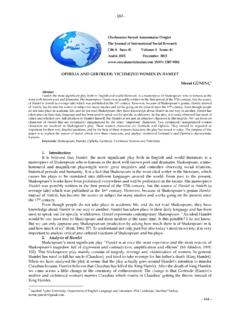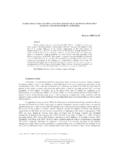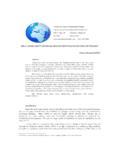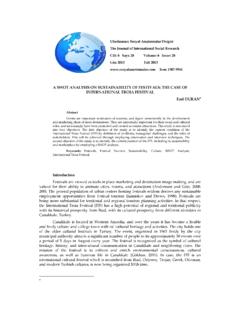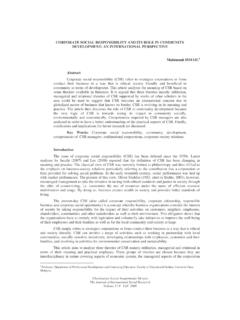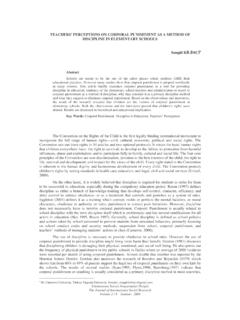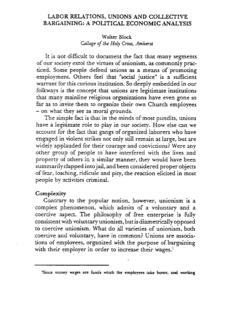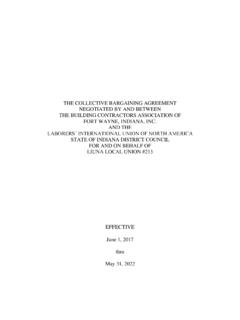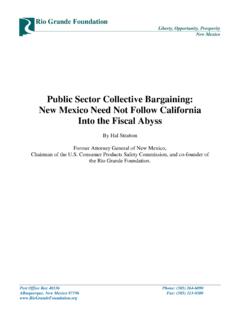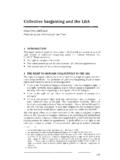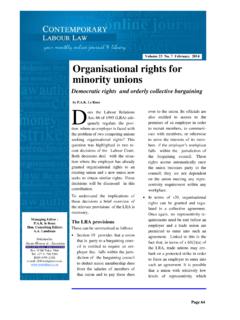Transcription of rose che raduan - sosyalarastirmalar.com
1 ENVIRONMENTAL CHANGES AND collective bargaining PRIORITIES: ANALYSIS, IMPLICATIONS AND OUTLINE FOR FUTURE RESEARCH Prof. Dr. raduan Che ROSE* Dr. Naresh KUMAR** Dr. Harris GANI** Abstract There has been limited attempt to examine the issue of collective bargaining , the changes in the larger industrial relations environment and the impact of these changes on Malaysian trade union movement. Thus a study was conducted to enhance the understanding of the process of collective bargaining and the underlying environment within which it is conducted.
2 The emphasis is to examine the nature, extent, and scope of changes in the sector/industry environment, management strategies, workplace practices, and work environment and how they shaped collective bargaining priorities among private sector employee unions in Malaysia. The findings of this research have several practical and theoretical implications. Keywords: Environmental Changes, collective bargaining , Employee Unions, Private Sector, Malaysia * Faculty of Economics and Management, Universiti Putra Malaysia, ** Faculty of Economics and Management, Universiti Putra Malaysia, ** Department of Labour, Peninsular Malaysia, Ministry of Human Resources, Malaysia Uluslararas Sosyal Ara t rmalar Dergisi The Journal of International Social Research Volume 1/5 Fall 2008 Environmental Changes And collective bargaining Priorities.
3 Analysis, Implications And Outline For Future Research 685 Introduction The influences of the underlying environment on industrial relations as a whole and on collective bargaining per se are well established in literature. Commons (1909), a century earlier has shown the influence of the economic factor the product market competition on collective bargaining . Dunlop (1958) theorized that dynamic interaction among labour, management and government in the environment of an industrial relations system, in particular the market and budgetary context, the technological settings, and the power context in the larger society as tools in understanding what is happening to industrial relations processes (such as collective bargaining ) and outcomes (such as contract agreement).
4 Changes in the environment contexts of the system have far reaching consequences. Several scholars after Dunlop provided both modification and refinement of the system approach to better understand how the environment contexts are shaping industrial relations processes and outcomes (Wood et al., 1975; Begin & Beal, 1989; Kochan, Locke, & Piore, 1992; Katz & Kochan, 2004). But this phenomenon of the constant changes in the environment and its consequences on industrial relations in the developed economies has not wholeheartedly been engaged by industrial relations theory and adequately addressed in the literature of industrial relations (Bognanno and Kleiner, 1992; Gagnon, 1998; Debrah and Smith, 2002; Haworth and Hughes, 2003).
5 This deficiency is unwarranted as there has been long-standing discussions and debates concerning extend to which collective bargaining outcomes diverge from those that would have resulted from the operation of the changes in the environment (Beaumont, 1990). The advent of globalisation and the associated forces of globalisation have been significantly felt in the more advanced economies in recent decades help to explain the availability of the majority studies conducted on the consequences of changes in the environment on collective bargaining .
6 There have been limited attempts to examine and answer the questions on the nature, extent, and scope of environmental changes at the workplace and their effects on bargaining in Malaysia. This was to some extent, the view of Jomo (1989) when he stated that since Malaysia is trying to emulate certain industrial relations policies from Taiwan and Korea under former prime minister, Tun Dr. Mahathir s Look East Policy in 1983, there would be changes at firm-level such as the introduction of enterprise unionism, employee participation, work culture, total quality management, quality circles, work organisations, and work ethics.
7 These are the factors that have been taken into consideration in the present study Uluslararas Sosyal Ara t rmalar Dergisi The Journal of International Social Research Volume 1/5 Fall 2008 686 Prof. Dr. raduan Che ROSE - Dr. Naresh KUMAR - Dr. Harris GANI In Malaysia the studies of trade unionism were mostly broad in nature. The notable works of Awberry and Dalley (1948), Azizan Bahari (1989), Gamba (1955), Jomo and Todd (1988; 1994), Miller (1992), Rudner (1973), Wad (1988) and Wilson (1981) are some of the commendable investigation of organized labour in Malaysia.
8 There has been limited attempt to examine the issue of collective bargaining , the changes in the larger industrial relations environment and the impact of these changes on Malaysian trade union movement. Some of the notable works that touches on the aforementioned environmental contexts in shaping industrial relations in Malaysia and are much debated are (i) economics: industrialisation strategies (Kuruvilla, 1993; 1996a; 1996b, Kuruvilla, & Arudsothy, 1995; Kuruvilla and Venkataraman, 1996), industrialisation levels and capital accumulation (Sharma, 1996), capital transformation (Yun, 1990), and employment structures (Ariffin, 1997); (ii) political/historical: the dominant role of the State (Deyo, 1989; Arudsothy, 1990.)
9 Arudsothy and Littler, 1993; Bhopal and Rowley, 2002); and (iii) sociological/behavioural factors: local conditions such as religion, cultures, ethnic composition and management system (Parasuraman,2004). Unfortunately most of the studies are conducted at macro level, rather general and limited in nature and are mostly policy based. There is a vacuum in literature in term of studies at the micro level analysis of the collective bargaining environments, the nature, extent and scope of the changing environment and its relationship with firm-level industrial relations practices and outcomes and their effects on organised labour in Malaysia.
10 Nevertheless there are a few studies which are praiseworthy. Kuruvilla and Arudsothy (1995) looked into the industrial relations/human resources practices and future trends in Malaysian manufacturing. The study revealed that in term of employment and staffing, job security is not well established; there was a noticeable trend toward temporary or causal employment and outsourcing. In term of compensation, traditional form of wage payment dominates Malaysian business landscape. In short, the projected future changes in the environment are: i) intensified competition and the need for upgrading of labour force skills through education, training and labour market policies, and ii) rapid technological change and its effect on production methods and work organisation.
